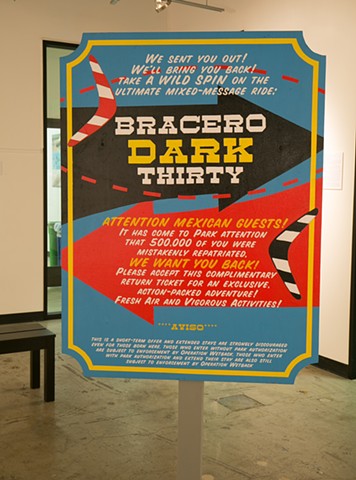Califas (2013)
Jenifer K. Wofford & Kyle Herbert
Fronteraland, 2013
Acrylic paint and vinyl on wood
Fronteraland was originally a temporary outdoor art installation on the grounds of the Bruns Ampitheater in Orinda, CA, created in response to California Shakespeare Theater’s staging of Richard Montoya’s play American Night in May/June 2013. Inspired by the raucous, witty, funhouse-esque qualities of the play, the Bruns grounds was reimagined as a quasi-amusement park/metaphor for the U.S. called Fronteraland. The “park” hosted a series of large hand-made signs advertising fictional rides and attractions related to factual American immigration and citizenship histories. The signs reference specific episodes in American history that affected those coming here or already here as natives, guests, residents, and citizens. As with a traditional amusement park sign, each Fronteraland sign advertises the thrilling conditions that an attraction has to offer, but also states, in small print, its limitations and conditions of exclusion. By playing on childhood memories of urgently wanting to be on a ride, and being either excited and terrified to be on it, or disappointed and excluded to not be allowed, Fronteraland supplemented American Night by actively and playfully engaging audience members in some more of the historic terms of exclusion from (or within) the U.S.
BRACERO DARK THIRTY In the 1930s, during the Great Depression, more than 500,000 Mexican Americans were deported or pressured to leave, during the Mexican Repatriation. However, when labor demand returned with World War II, there were few Mexican Americans available. The Bracero Program (from Spanish bracero: "manual laborer") was therefore initiated in 1942 to import temporary contract laborers from Mexico to the U.S. The program began with the U.S. government bringing in a few hundred experienced Mexican agricultural to harvest sugar beets in the Stockton, CA area. The program soon spread to cover most of the U.S. agricultural labor market. There was also a railroad bracero program that initially supplied U.S. railroads with unskilled workers for railroad track maintenance and eventually covered other unskilled and skilled labor. By 1945, the quota for the agricultural program was more than 75,000 braceros working in the U.S. railroad system and 50,000 braceros working in U.S. agriculture at any one time. The railroad program ended with the conclusion of World War II in 1945. At the behest of U.S. growers, who claimed ongoing labor shortages, the program was extended under a number of acts of congress until 1948. The program in agriculture was justified in the U.S. largely as an alternative to illegal immigration and was seen as a complement to efforts to deport undocumented immigrants such as Operation Wetback, under which 1,075,168 Mexicans were deported in 1954. The workers who participated in the Bracero Program generated significant local and international struggles challenging the U.S. and Mexican governments to identify and return 10% mandatory deductions taken from their pay from 1942 to 1948, for savings accounts that they were legally guaranteed to receive upon their return to Mexico at the conclusion of their contracts. It is estimated that, with interest accumulated, $500 million is owed to ex-braceros, who continue to fight to receive the money owed to them.
Califas
October 2 – December 21, 2013
Intersection for the Arts
San Francisco, CA
Photo credit: Scott Chernis
